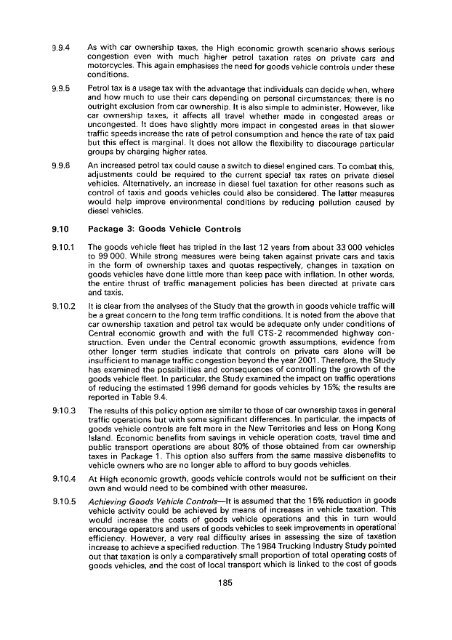Untitled - HKU Libraries - The University of Hong Kong
Untitled - HKU Libraries - The University of Hong Kong
Untitled - HKU Libraries - The University of Hong Kong
- No tags were found...
You also want an ePaper? Increase the reach of your titles
YUMPU automatically turns print PDFs into web optimized ePapers that Google loves.
9.9.4 As with car ownership taxes, the High economic growth scenario shows seriouscongestion even with much higher petroi taxation rates on private cars andmotorcycles. This again emphasises the need for goods vehicle controls under theseconditions.9.9.5 Petrol tax is a usage tax with the advantage that individuals can decide when, whereand how much to use their cars depending on personal circumstances; there is nooutright exclusion from car ownership. It is also simple to administer. However, likecar ownership taxes, it affects all travel whether made in congested areas oruncongested. It does have slightly more impact in congested areas in that slowertraffic speeds increase the rate <strong>of</strong> petrol consumption and hence the rate <strong>of</strong> tax paidbut this effect is marginal. It does not allow the flexibility to discourage particulargroups by charging higher rates.9.9.6 An increased petrol tax could cause a switch to diesel engined cars. To combat this,adjustments could be required to the current special tax rates on private diese!vehicles. Alternatively, an increase in diesel fuel taxation for other reasons such ascontrol <strong>of</strong> taxis and goods vehicles could also be considered. <strong>The</strong> latter measureswould help improve environmental conditions by reducing pollution caused bydiesel vehicles.9.10 Package 3: Goods Vehicle Controls9.10.1 <strong>The</strong> goods vehicle fleet has tripled in the last 12 years from about 33000 vehiclesto 99 000. While strong measures were being taken against private cars and taxisin the form <strong>of</strong> ownership taxes and quotas respectively, changes in taxation ongoods vehicles have done little more than keep pace with inflation, in other words,the entire thrust <strong>of</strong> traffic management policies has been directed at private carsand taxis.9.10.2 It is clear from the analyses <strong>of</strong> the Study that the growth in goods vehicle traffic willbe a great concern to the long term traffic conditions. It is noted from the above thatcar ownership taxation and petroi tax would be adequate only under conditions <strong>of</strong>Central economic growth and with the full CTS-2 recommended highway construction.Even under the Central economic growth assumptions, evidence fromother longer term studies indicate that controls on private cars alone will beinsufficient to manage traffic congestion beyond the year 2001. <strong>The</strong>refore, the Studyhas examined the possibilities and consequences <strong>of</strong> controlling the growth <strong>of</strong> thegoods vehicle fleet In particular, the Study examined the impact on traffic operations<strong>of</strong> reducing the estimated 1996 demand for goods vehicles by 15%; the results arereported in Table 9.4.9:10.3 <strong>The</strong> results <strong>of</strong> this policy option are similar to those <strong>of</strong> car ownership taxes in generaltraffic operations but with some significant differences. In particular, the impacts <strong>of</strong>goods vehicle controls are felt more in the New Territories and less on <strong>Hong</strong> <strong>Kong</strong>Island. Economic benefits from savings in vehicle operation costs, travel time andpublic transport operations are about 80% <strong>of</strong> those obtained from car ownershiptaxes in Package 1. This option also suffers from the same massive disbenefits tovehicle owners who are no longer able to afford to buy goods vehicles.9.10.4 At High economic growth, goods vehicle controls would not be sufficient on theirown and would need to be combined with other measures.9.10.5 Achieving Goods Vehicle Controls— It is assumed that the 15% reduction in goodsvehicle activity could be achieved by means <strong>of</strong> increases in vehicle taxation. Thiswould increase the costs <strong>of</strong> goods vehicle operations and this in turn wouldencourage operators and users <strong>of</strong> goods vehicles to seek improvements in operationalefficiency. However, a very real difficulty arises in assessing the size <strong>of</strong> taxationincrease to achieve a specified reduction. <strong>The</strong> 1984 Trucking Industry Study pointedout that taxation is only a comparatively small proportion <strong>of</strong> total operating costs <strong>of</strong>goods vehicles, and the cost <strong>of</strong> local transport which is linked to the cost <strong>of</strong> goods185
















